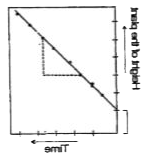In arithmetic method, if one cell divides, count the number of daughter cells after three divisions are
8
1
4
2
The correct Answer is:C
To solve the problem of counting the number of daughter cells after three divisions using the arithmetic method, we can follow these steps:
1. Understand the Initial Condition: Start with one cell that will undergo division.
2. First Division:
- The initial cell divides into two daughter cells.
- Total daughter cells after the first division = 2.
3. Second Division:
- In the arithmetic method, only one of the daughter cells divides again, while the other matures and does not divide.
- The dividing daughter cell produces two new daughter cells.
- Total daughter cells after the second division = 2 (from the first division) + 2 (newly divided) = 4.
4. Third Division:
- Again, only one of the daughter cells from the previous total of four will divide.
- This dividing daughter cell produces two new daughter cells.
- Total daughter cells after the third division = 4 (from the second division) + 2 (newly divided) = 6.
5. Final Count: After three divisions, the total number of daughter cells is 6.
Conclusion:
After three divisions in the arithmetic method, the total number of daughter cells is 6.
- The initial cell divides into two daughter cells.
- Total daughter cells after the first division = 2.
- In the arithmetic method, only one of the daughter cells divides again, while the other matures and does not divide.
- The dividing daughter cell produces two new daughter cells.
- Total daughter cells after the second division = 2 (from the first division) + 2 (newly divided) = 4.
- Again, only one of the daughter cells from the previous total of four will divide.
- This dividing daughter cell produces two new daughter cells.
- Total daughter cells after the third division = 4 (from the second division) + 2 (newly divided) = 6.
After three divisions in the arithmetic method, the total number of daughter cells is 6.
Similar Questions
Name the three types of cell division.
View SolutionIn eukaryotes, the process of division of a somatic parent cell into two daughter cells is known as mitosis. During the M or mitosis phase of a cell cycle, the chromosomes present in the nucleus are separated into two identical sets, which eventually form two daughter nuclei. This is followed by cytokinesis. Onion root tips are most commonly used to observe the different stages of mitosis in the laboratory. Each onion cell contains a total of eight chromosomes. DNA specific stains are used to visualise these chromosomes in different phases of mitosis.
Considering the number of chromosomes in an onion cell is 8, what would be the number of chromosomes in each daughter cell after mitosis ?View Solution
Knowledge Check
- Question 1 - Select One
Four daughter cells formed after meiosis are
AGenetically similarBGenetically differentCAnucletateDMultinucleate - Question 2 - Select One
Four daughter cells formed after meiosis are
AGenetically similarBGenetically differentCAnucleateDMultinucleate - Question 3 - Select One
Two daughter cells formed after mitosis are
ANon-identical to each otherBIdentical to each otherCNon-identical to parentsDIrregular is size
In geometric method, if one meristematic cell divides three times then the number of meristematic cells formed are
View Solutionin arithmetic growth, following mitotic cell division, only one daughter cell continues to divide while the other differentiates and matures. The simplest expression of arithmetic growth is exemplified by a root elongating at a constant rate. On plotting the length of the organ against time, a linear curve is obtained, as seen in the graph. Mathemati cally, it is expressed as -
 View Solution
View SolutionN/C ratio after cell division
View SolutionThe division of one cell into two new similar daughter cells is called
View SolutionIn the meiotic cell division, 56 daughter cells are produced by two successive divisions in which
View Solution

